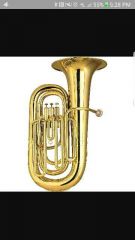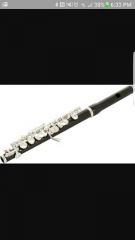![]()
![]()
![]()
Use LEFT and RIGHT arrow keys to navigate between flashcards;
Use UP and DOWN arrow keys to flip the card;
H to show hint;
A reads text to speech;
50 Cards in this Set
- Front
- Back
|
Tuba |

Bass instrument in the brass family |
|
|
Conjunct |
Describes a melody that moves by small intervals |
|
|
Melody |
Succession of single tones or pitches perceived as a unit |
|
|
Beat |
The basic unit of rhythm that divides time into equal segments |
|
|
Interval |
The distance between 2 pitches |
|
|
Countermelody |
One melody added to, or played against another melody |
|
|
Musical sounds are represented by a symbol called a |
Note |
|
|
Rhythm |
The element of music that organizes movement in time |
|
|
Interval |
The distance and relationship between 2 tones |
|
|
Meter is marked off in groups knows as: |
Measures |
|
|
Duple Meter |
The meter that would most likely be associated with a march/ marching band |
|
|
Syncopation |
The deliberate shifting of the accent to a weak beat or an offbeat |
|
|
Chord |
Combination of 3 or more tones that constitutes a single block of harmony |
|
|
Scale |
A collection of pitches arranged in ascending or descending order |
|
|
Triad |
-3 alternate pitches of scale -Most common chord type found in western music -Built on alternative scale steps |
|
|
Should a composer write a film score to a horror movie one might reasonably expect that the harmony would include a great deal of: |
Dissonance |
|
|
Consonant |
Describes a concordant or agreeable combination of tones |
|
|
Dissonance |
Combination of tones that sound discordant, unstable, or in need of resolution |
|
|
Homorhythm |
Texture in which all the voices move in the same rhythm |
|
|
Monophony |
Texture featuring a single, unaccompanied line |
|
|
Polyphony |
Texture that combines 2 or more simultaneous melodic lines |
|
|
Round |
Term that best describes row, row, row, your boat |
|
|
Imitation |
The procedure in which a melodic idea is presented in one voice and then restarted in another |
|
|
Round |
Simple and familiar type of canon |
|
|
Improvisation |
Technique in which performers create music on the spot |
|
|
Sequence |
The restatement of a musical idea at a higher or lower pitch |
|
|
Italian |
The language which tempo markings are generally given |
|
|
Tempo |
The rate of speed at which a piece of music is played |
|
|
Slow tempo music |
Largo, adagio, gravé |
|
|
Accelerando |
Speeding up |
|
|
Dynamics |
The degree of loudness or softness or the volume at which music is played |
|
|
Crescendo |
Gradual swelling of the volume of music |
|
|
PP |
Softest markings of dynamics |
|
|
Timbré |
The quality of sound that distinguishes one instrument or voice from another |
|
|
Standard ranges of the human voice from highest to lowest |
Soprano Alto Tenor Bass |
|
|
Tenor |
Generally accepted term for the highest male vocal range |
|
|
Instruments of the western orchestra are characterized into these 4 groups |
Brass String Percussion Woodwinds |
|
|
String instruments that are NOT bowed |
Guitar Banjo Madallen |
|
|
Highest to lowest range of bowed string instruments |
Violin Viola Chello Double bass |
|
|
Piccalo |

Highest sounding member of woodwind family |
|
|
Members of the bass family |
Horn Trumpet Trombone Tuba |
|
|
Members of the percussion family |
Timpani Xylophone Marriba Drum |
|
|
-made of metal -blown with metal mouthpiece -sound is created by vibration of lips |
Facts about all brass instruments |
|
|
Percussion family is comprised of a variety of instruments that are made to sound by: |
Striking the instrument |
|
|
Timpani are members of the _____ family of instruments |
Percussion |
|
|
Chorus/ choir |
Fairly large body of singers who perform together |
|
|
Voices without music |
A' capella |
|
|
Universal functions of music in world cultures |
-workers get jobs done more efficiently -religous and civic ceremonies -music -expression of emotion |
|
|
Genre |
General Term suggest something of the overall character of a work/song as well as its function |
|
|
Chronological order of musical periods |
Middle ages Renaissance period Baroque period Classical period Romantic period Impressionist period Twentieth century and beyond |

